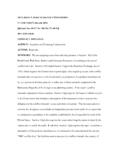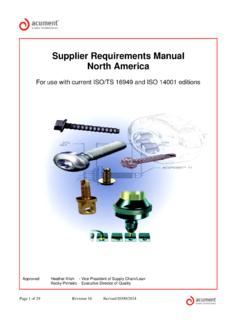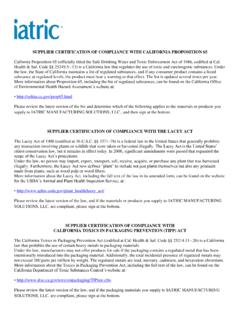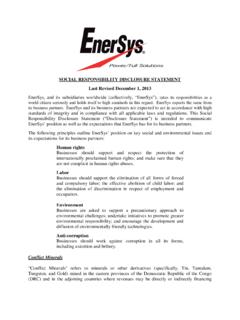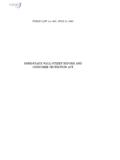Transcription of Template and Appendix for 3TG Downstream Supplier Letter
1 1 Template and Appendix for 3TG Downstream Supplier Letter Dear [ Supplier ], The purpose of this Letter is to: 1) provide you with an understanding of our commitment to sourcing [MINERALS] from conflict-affected and high-risk areas in line with our corporate policy, legal obligations and existing international standards; and 2) ask you to collect important supply chain data to fulfil our legal obligations under the Dodd-Frank Wall Street Reform and Consumer Protection Act (Section 1502). OR 2) ask you to collect important supply chain data to satisfy the expectations of our customers, stakeholders and regulators. OPTIONAL: 3) provide you with instructions on how and when to submit supply chain information to us. Please provide a response by [DATE]. Our commitment to sourcing minerals responsibly [COMPANY] is committed to ensure that [MINERALS] contained in our products are sourced with due respect for human rights, the need to avoid contributing to conflict, and the desire to support development through our supply chain practices.
2 At the same time, [COMPANY] does not ban the use of [MINERALS] that originate in conflict-affected and high-risk areas when they are sourced in accordance with existing international This Letter is proposed by a sub-set of the Downstream 3T pilot participants to promote consistency of Supplier communications on sourcing minerals (3TG) from conflict-affected and high-risk areas. It is intended as a Template only, for companies to customise and tailor. The main Letter includes optional texts which companies can choose to include or not. The main Letter is followed by an Appendix with detail on specific items and a list of useful resources which companies may choose to incorporate as an Addendum to the main Letter . 2 standards. Avoiding the sourcing of all [MINERALS] from these areas would cause a de facto embargo with serious adverse impact on the living conditions of local populations.
3 OPTIONAL: Please find here a link to [COMPANY s] conflict minerals policy, which we expect our suppliers to follow. We are using the OECD Due Diligence Guidance as an international framework for meeting the sourcing expectations of our customers, regulators and stakeholders. OPTIONAL: The SEC has stated that OECD Guidance may be used as a framework for purposes of satisfying the reporting requirements under law, including the steps to be taken to determine the source and chain of custody of the conflict minerals. OPTIONAL: [COMPANY] understands that you as a Supplier may not be able to guarantee that the parts you deliver to us are conflict-free, but you can help to identify smelters in our common supply chain, which is a necessary step in determining the source and chain of custody of the MINERALS in our products. Smelters and other upstream suppliers are those who can most effectively and most directly mitigate the risks on the ground.
4 We are asking: 1) all our suppliers of products containing [MINERALS] to provide information to identify the smelters/refiners in their supply chains using [NAME OF COLLECTION TOOL such as the EICC/GeSI Conflict Minerals Reporting Template ]. The [NAME OF COLLECTION TOOL] will protect confidential and business sensitive information through roll-up tools that do not require a list of all suppliers used within a company s supply chain; OR 1) our most significant suppliers of products containing [MINERALS] to provide information to identify the smelters/refiners in their supply chains using [NAME OF COLLECTION TOOL]. The [NAME OF COLLECTION TOOL] will protect confidential and business sensitive information through roll-up tools that do not require a list of all suppliers used within a company s supply chain. 2) OPTIONAL: We are also incorporating into [our standard purchase order/contract terms and conditions/ Supplier expectations/other binding document] provisions requiring you to adopt a policy on the responsible sourcing of [MINERALS], to implement due diligence processes in support of that policy, and to provide to us periodically information we need to support our obligations [under Dodd-Frank] and our policy.
5 We will compare smelters/refiners used by relevant suppliers against an independently-verified list of smelters using responsibly sourced minerals [identified through industry programs such as the Conflict Free Smelter Program]. We will specify to our direct suppliers any smelters we become aware of that have been identified as performing due diligence on their minerals in line with industry or national standards and the OECD Guidance. 3 Next steps and important dates: OPTIONAL: We ask that you complete the data gathering form (or link) attached to this Letter and return it to [COMPANY] by [DATE]. Incomplete forms will be returned for completion. We will file our first Conflict mineral report as required by Dodd-Frank on 31 May 2014 for the calendar year reporting period of 2013. OR We will publish our findings and progress on due diligence for responsible mineral sourcing on an annual basis.
6 We recognise that achieving a responsible supply chain will take time and effort. We expect that you take reasonable, good-faith steps toward this goal. Thank you for your cooperation and support. [COMPANY NAME] End of main Letter Appendix ITEMS Note: These sections may be added into the main text if needed, or added as addendums to the main Letter , based on each company s discretion 1) The Dodd-Frank Act Section 1502 We are working to comply with new disclosure obligations under law (Section 1502 of the Dodd-Frank Wall Street Reform and Consumer Protection Act of 2010) applicable to stock exchange listed companies concerning the 3TG (so called conflict minerals ) used in their products to inquire into the origin of 3TG in their supply chains and report whether trade in these minerals may support conflict in the Democratic Republic of the Congo (DRC) and its 9 neighbouring countries.
7 The first report must be filed on May 31, 2014 based on use of 3TG in calendar year 2013. 2) OECD Due Diligence Framework to help companies source responsibly from conflict-affected and high-risk areas The SEC has stated that OECD Guidance may be used as a framework for purposes of satisfying the reporting requirements, including the steps to be taken to determine the source and chain of custody of the conflict minerals. 4 Step 1: Establish strong company management systems and strengthen company engagement with suppliers Introduce a supply chain transparency system that allows, to the best of our efforts, for the identification of the smelters in our supply chain through which information on mineral origin can be obtained. We will seek to do this through various means, including but not limited to: Through discussions with the our immediate suppliers, Through the incorporation of Supplier disclosure requirements into Supplier contracts, By specifying to our direct suppliers any smelters we become aware of that have been identified as meeting the requirements of the OECD Guidance, When available, by using confidential information-sharing systems on suppliers [such as the EICC-GeSI Common Reporting Template ], Through any available industry-wide schemes to identify smelters in the supply chain [such as the CFS Program developed by EICC-GeSI].
8 Step 2: Identify and asses risk in the supply chain We assess risk in the supply chain as information on smelters is progressively built in order to assess their due diligence practices and verify whether smelters source minerals responsibly and do not support conflict. Step 3: Design and implement a strategy to respond to identified risk If we become aware of a Supplier whose due diligence needs improvement and we intend to continue the trade relationship, we will work with that Supplier to improve its performance, including through training modules that may become available through industry organisations. We expect our suppliers to take similar measures with their suppliers to ensure alignment throughout the supply chain. Step 4: Ensure third-party audits of smelter s due diligence We support efforts and encourage our suppliers to also support industry organisations efforts to ensure that smelters due diligence sourcing practices are audited by independent third party auditors.
9 Step 5: Report annually on supply chain due diligence We will publish our findings and progress on an annual basis beginning with the filing of our report on 31 May 2014 for the first calendar year reporting period of 2013 on our website at [PROVIDE LINK]. 5 3. Due Diligence Tools: Note: This is not an exhaustive list, and companies and their suppliers are encouraged to check on the websites of the key industry organisations for future updates and new tools Standard reporting tools EICC-GeSI Standard Reporting Template Conflict-Free Smelter Program: The Conflict Minerals Platform Tool by iPoint: 4. Other resources: Industry Association web pages for data gathering tools, training programs, information about regulations Aerospace & Defense: Electronics: , and Automotive: Other: OECD: The OECD webpage dedicated to helping businesses source responsibly: Key documents for companies and businesses (keyword conflict minerals ) The US Securities and Exchange Commission (SEC): [COMPANY] own webpage on Conflict Minerals/Responsible Sourcing (if available) END










